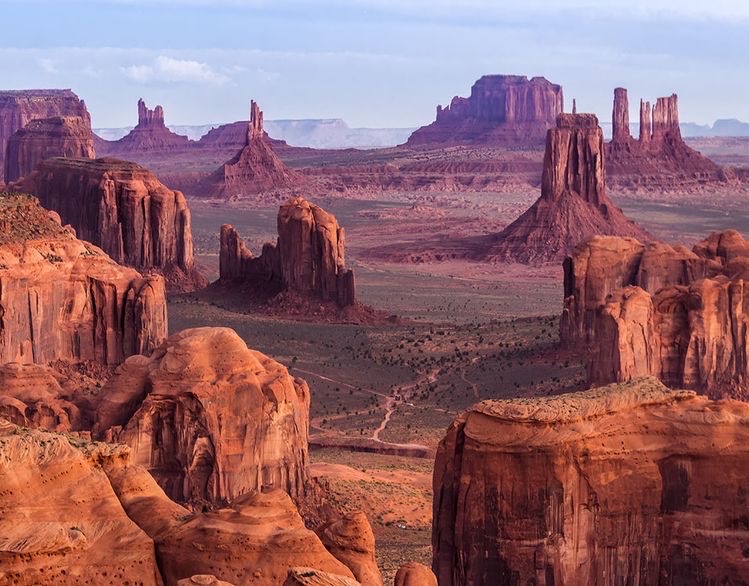Monument Valley – A Sacred Landscape of the American Southwest

Monument Valley isn’t just a place—it’s a symbol. Its towering sandstone formations, framed by endless skies and glowing red sands, are instantly recognizable, even to those who’ve never set foot in the Southwest. But beyond the iconic imagery lies a landscape steeped in history, culture, and natural wonder.
Straddling the border of Arizona and Utah, Monument Valley is a place where the power of nature and the stories of the Navajo people converge. This is a land of stark beauty and spiritual resonance, protected and cherished for generations.
A Geological Masterpiece
The dramatic formations of Monument Valley began over 250 million years ago when the area was part of a vast lowland basin. Layers of sandstone and siltstone were deposited, compressed, and later uplifted by tectonic forces. Over millennia, wind and water carved the mesas, buttes, and spires that define the valley today.
The Iconic Features
Some of the most famous formations include:
- The Mittens: Two massive buttes with "thumb-like" spires, standing as sentinels of the valley.
- Totem Pole: A slender sandstone pillar rising 450 feet, a striking contrast to the flat desert around it.
- Ear of the Wind: A graceful arch eroded into sandstone, one of the many natural wonders hidden throughout the valley.
Each formation holds its own story, shaped by both nature and Navajo lore.
Sacred Ground: The Navajo Connection
To the Navajo people, who call themselves the Diné, Monument Valley is not just beautiful—it’s sacred. Known as Tsé Biiʼ Ndzisgaii, or “Valley of the Rocks,” the area is deeply intertwined with their spiritual beliefs and traditions.
Cultural Significance
- The valley’s towering formations are seen as sacred beings, representing ancient spirits and deities.
- Ceremonial practices, including prayer and offerings, are still performed here, maintaining a deep connection to the land.
Visitors to Monument Valley are reminded to tread with respect, recognizing that this is not just a park—it’s a living cultural landscape.
Exploring Monument Valley
Managed by the Navajo Nation, Monument Valley Tribal Park offers visitors a chance to experience this awe-inspiring landscape up close. Here’s how to make the most of your visit:
1. Scenic Drives
The 17-mile Valley Drive is a self-guided tour that winds through the heart of the valley. Along the way, you’ll encounter breathtaking viewpoints and get close to iconic formations like the Mittens and John Ford’s Point, named after the legendary filmmaker who immortalized the valley in classic Westerns.
2. Guided Tours
For a deeper experience, join a guided tour led by Navajo guides. These excursions often include access to areas not open to the general public, as well as insights into the valley’s history, geology, and cultural significance. Popular options include:
- Jeep Tours: Explore rugged trails with ease.
- Horseback Rides: Experience the valley like the Navajo ancestors did, on horseback.
- Photography Tours: Perfect for capturing the valley’s ever-changing light and shadow.
3. Stargazing
With its remote location and minimal light pollution, Monument Valley offers some of the best stargazing in the world. Under a canopy of stars, the formations take on a mystical glow, and the quiet of the desert feels infinite.
Wildlife and Ecology
Despite its arid appearance, Monument Valley supports a surprising variety of life.
- Desert Plants: Yucca, sagebrush, and juniper trees dot the landscape, adapted to the harsh conditions.
- Birds: Hawks, ravens, and golden eagles are common, soaring above the sandstone spires.
- Desert Mammals: Coyotes, foxes, and jackrabbits can occasionally be spotted, especially during the cooler hours of dawn and dusk.
Conservation and Stewardship
Monument Valley is not part of the National Park system; it is protected and managed by the Navajo Nation. This unique arrangement reflects a commitment to both preserving the land and honoring its cultural heritage.
Challenges
- Tourism Impact: With over 350,000 visitors annually, managing foot traffic and preserving the fragile desert ecosystem is an ongoing challenge.
- Cultural Respect: Balancing public access with the spiritual significance of the land requires thoughtful policies and community involvement.
Visitors are encouraged to follow Leave No Trace principles and respect Navajo customs, ensuring that this sacred landscape remains pristine and honored for generations.
The Legacy of Monument Valley
Monument Valley’s striking beauty has captured the imagination of countless artists, filmmakers, and travelers. Its iconic silhouette has graced everything from John Wayne movies to album covers, making it a symbol of the untamed American West.
But beyond its fame, Monument Valley remains a deeply personal place—a living testament to the enduring relationship between people and the land. For the Navajo, it is a source of identity and spirituality. For visitors, it is a humbling reminder of nature’s power and the importance of preserving these sacred spaces.
Plan Your Visit
- Best Time to Visit: Spring and fall offer mild temperatures and the best conditions for exploring.
- Permits: Entry fees support the Navajo Nation’s conservation efforts. Guided tours may require additional bookings.
- Accommodations: Stay at The View Hotel, which offers unparalleled vistas of the valley, or consider camping under the stars at the park’s designated sites.
Monument Valley: A Sacred Vision of the West
Standing at the edge of Monument Valley, with its towering buttes casting long shadows over the desert floor, you can feel the weight of time. This land is more than a backdrop—it’s a story written in stone, shaped by wind and water, and carried forward by the Navajo people who protect it.
Monument Valley reminds us of the beauty and complexity of the American Southwest, a place where conservation and culture intertwine to create a legacy that is both timeless and alive.








